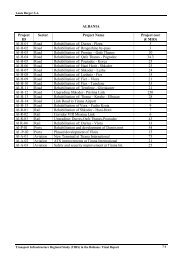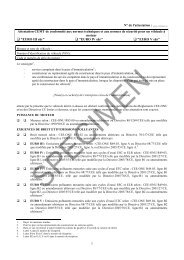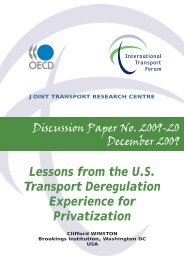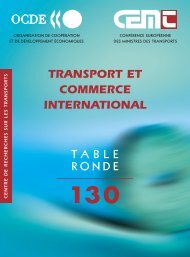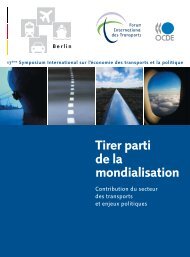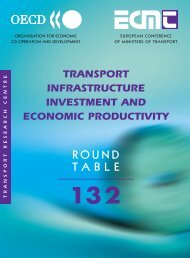Understanding the Value of Transport Infrastructure ...
Understanding the Value of Transport Infrastructure ...
Understanding the Value of Transport Infrastructure ...
You also want an ePaper? Increase the reach of your titles
YUMPU automatically turns print PDFs into web optimized ePapers that Google loves.
UNDERSTANDING THE VALUE OF TRANSPORT INFRASTRUCTURE<br />
structures are frequently undertaken well before <strong>the</strong> end <strong>of</strong> <strong>the</strong>ir normal service<br />
lives;<br />
b. Major renovations or enlargements increase <strong>the</strong> performance or capacity <strong>of</strong><br />
existing fixed assets or significantly extend <strong>the</strong>ir previously expected service lives.<br />
Enlarging or extending an existing building or structure obviously constitutes a<br />
major change in this sense, but a complete refitting or restructuring <strong>of</strong> <strong>the</strong> interior<br />
<strong>of</strong> a building also qualifies” (SNA, para. 6.229).<br />
Time <strong>of</strong> recording<br />
Apart from <strong>the</strong> delineation between investments and current expenditures, <strong>the</strong> 2008 SNA<br />
also provides more detailed guidance on <strong>the</strong> time <strong>of</strong> recording, <strong>the</strong> valuation <strong>of</strong><br />
transactions, and <strong>the</strong> ownership <strong>of</strong> transport infrastructure.<br />
As transport infrastructure typically takes more than a year to complete, <strong>the</strong> issues<br />
regarding <strong>the</strong> time <strong>of</strong> recording is quite relevant for this type <strong>of</strong> investment. “The general<br />
principle for <strong>the</strong> time <strong>of</strong> recording <strong>of</strong> acquisitions … <strong>of</strong> fixed assets is when <strong>the</strong> ownership<br />
<strong>of</strong> <strong>the</strong> fixed assets is transferred to <strong>the</strong> institutional unit that intends to use <strong>the</strong>m in<br />
production” (SNA, para. 10.53). This is also true for fixed assets that take more than a<br />
year to produce. However, “… when stage payments are made, <strong>the</strong>se are regarded as<br />
purchase <strong>of</strong> (part <strong>of</strong>) a fixed asset or as a trade advance if <strong>the</strong> value <strong>of</strong> <strong>the</strong> stage<br />
payment exceeds <strong>the</strong> value <strong>of</strong> <strong>the</strong> work put in place. In <strong>the</strong> latter case, work is recorded<br />
as fixed capital delivered to <strong>the</strong> final owner as work proceeds until <strong>the</strong> trade credit is<br />
exhausted” (SNA, para. 10.55). The recording <strong>of</strong> stage payments as capital formation,<br />
including <strong>the</strong> addition <strong>of</strong> <strong>the</strong>se investments to <strong>the</strong> capital stock is somewhat disputable,<br />
as <strong>the</strong> relevant incomplete structures cannot yet be used in <strong>the</strong> production <strong>of</strong> goods and<br />
services. An alternative could be to distinguish <strong>the</strong>se structures from <strong>the</strong> capital stock <strong>of</strong><br />
completed assets used in production.<br />
Valuation<br />
In relation to <strong>the</strong> valuation <strong>of</strong> <strong>the</strong> purchases <strong>of</strong> assets, <strong>the</strong> “costs incurred on <strong>the</strong><br />
acquisition <strong>of</strong> an asset are treated as an integral part <strong>of</strong> <strong>the</strong> value <strong>of</strong> that unit’s gross<br />
fixed capital formation” (SNA, para. 10.49). More specifically, <strong>the</strong>se so-called costs <strong>of</strong><br />
ownership transfer consist <strong>of</strong> <strong>the</strong> following cost categories:<br />
a. All pr<strong>of</strong>essional charges or commissions incurred by both units acquiring or<br />
disposing <strong>of</strong> an asset, such as fees paid to lawyers, architects, surveyors,<br />
engineers and valuers, and commissions paid to estate agents and auctioneers;<br />
b. Any trade and transport costs separately invoiced to <strong>the</strong> purchaser;<br />
c. All taxes payable by <strong>the</strong> unit acquiring <strong>the</strong> asset on <strong>the</strong> transfer <strong>of</strong> ownership <strong>of</strong><br />
<strong>the</strong> asset;<br />
d. Any tax payable on <strong>the</strong> disposal <strong>of</strong> an asset;<br />
e. Any delivery and installation or de-installation costs not included in <strong>the</strong> price <strong>of</strong><br />
<strong>the</strong> asset being acquired or disposed <strong>of</strong>; and<br />
f. Any terminal costs incurred at <strong>the</strong> end <strong>of</strong> an asset’s life such as those required to<br />
render <strong>the</strong> structure safe or to restore <strong>the</strong> environment in which it is situated.<br />
© OECD/ITF 2013 11





